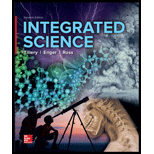
Integrated Science
7th Edition
ISBN: 9780077862602
Author: Tillery, Bill W.
Publisher: Mcgraw-hill,
expand_more
expand_more
format_list_bulleted
Concept explainers
Question
Chapter 4.4, Problem 11SC
To determine
The effect on the relative humidity of the sample of air that is cooling if no water vapor is added or removed from the sample.
Expert Solution & Answer
Want to see the full answer?
Check out a sample textbook solution
Students have asked these similar questions
A particle with a charge of − 5.20 nC is moving in a uniform magnetic field of (B→=−( 1.22 T )k^. The magnetic force on the particle is measured to be(F→=−( 3.50×10−7 N )i^+( 7.60×10−7 N )j^. Calculate the scalar product v→F→. Work the problem out symbolically first, then plug in numbers after you've simplified the symbolic expression.
Need help wity equilibrium qestion
need answer asap please thanks you
Chapter 4 Solutions
Integrated Science
Ch. 4.1 - Prob. 1SCCh. 4.2 - Using the absolute temperature scale, the freezing...Ch. 4.3 - Prob. 3SCCh. 4.3 - Prob. 4SCCh. 4.3 - Prob. 5SCCh. 4.3 - Prob. 6SCCh. 4.3 - Prob. 7SCCh. 4.3 - Prob. 8SCCh. 4.4 - Prob. 9SCCh. 4.4 - Prob. 10SC
Ch. 4.4 - Prob. 11SCCh. 4.4 - Compared to cooler air, warm air can hold a. more...Ch. 4 - What is temperature? What is heat?Ch. 4 - Prob. 2CQCh. 4 - Prob. 3CQCh. 4 - Prob. 4CQCh. 4 - Why is cooler air found in low valleys on calm...Ch. 4 - Prob. 6CQCh. 4 - Prob. 7CQCh. 4 - Prob. 8CQCh. 4 - Prob. 9CQCh. 4 - Prob. 10CQCh. 4 - Prob. 11CQCh. 4 - The relative humidity increases almost every...Ch. 4 - Prob. 13CQCh. 4 - Prob. 14CQCh. 4 - Prob. 15CQCh. 4 - Prob. 16CQCh. 4 - Prob. 17CQCh. 4 - Prob. 18CQCh. 4 - Prob. 19CQCh. 4 - Prob. 1PEACh. 4 - Prob. 2PEACh. 4 - Prob. 3PEACh. 4 - Prob. 4PEACh. 4 - Prob. 5PEACh. 4 - Prob. 6PEACh. 4 - Prob. 7PEACh. 4 - Prob. 8PEACh. 4 - Prob. 9PEACh. 4 - Prob. 10PEACh. 4 - Prob. 11PEACh. 4 - Prob. 12PEACh. 4 - Prob. 1PEBCh. 4 - Prob. 2PEBCh. 4 - Prob. 3PEBCh. 4 - Prob. 4PEBCh. 4 - A 60.0 kg person will need to climb a 10.0 m...Ch. 4 - Prob. 6PEBCh. 4 - Prob. 7PEBCh. 4 - Prob. 8PEBCh. 4 - Prob. 9PEBCh. 4 - Prob. 10PEBCh. 4 - Prob. 11PEBCh. 4 - Prob. 12PEB
Knowledge Booster
Learn more about
Need a deep-dive on the concept behind this application? Look no further. Learn more about this topic, physics and related others by exploring similar questions and additional content below.Similar questions
- A man slides two boxes up a slope. The two boxes A and B have a mass of 75 kg and 50 kg, respectively. (a) Draw the free body diagram (FBD) of the two crates. (b) Determine the tension in the cable that the man must exert to cause imminent movement from rest of the two boxes. Static friction coefficient USA = 0.25 HSB = 0.35 Kinetic friction coefficient HkA = 0.20 HkB = 0.25 M₁ = 75 kg MB = 50 kg P 35° Figure 3 B 200arrow_forwardA golf ball is struck with a velocity of 20 m/s at point A as shown below (Figure 4). (a) Determine the distance "d" and the time of flight from A to B; (b) Determine the magnitude and the direction of the speed at which the ball strikes the ground at B. 10° V₁ = 20m/s 35º Figure 4 d Barrow_forwardThe rectangular loop of wire shown in the figure (Figure 1) has a mass of 0.18 g per centimeter of length and is pivoted about side ab on a frictionless axis. The current in the wire is 8.5 A in the direction shown. Find the magnitude of the magnetic field parallel to the y-axis that will cause the loop to swing up until its plane makes an angle of 30.0 ∘ with the yz-plane. Find the direction of the magnetic field parallel to the y-axis that will cause the loop to swing up until its plane makes an angle of 30.0 ∘ with the yz-plane.arrow_forward
- A particle with a charge of − 5.20 nC is moving in a uniform magnetic field of (B→=−( 1.22 T )k^. The magnetic force on the particle is measured to be (F→=−( 3.50×10−7 N )i^+( 7.60×10−7 N )j^. Calculate the y and z component of the velocity of the particle.arrow_forwardneed answer asap please thank youarrow_forward3. a. Determine the potential difference between points A and B. b. Why does point A have a higher potential energy? Q = +1.0 C 3.2 cm 4.8 cm Aarrow_forward
arrow_back_ios
SEE MORE QUESTIONS
arrow_forward_ios
Recommended textbooks for you

 College PhysicsPhysicsISBN:9781938168000Author:Paul Peter Urone, Roger HinrichsPublisher:OpenStax College
College PhysicsPhysicsISBN:9781938168000Author:Paul Peter Urone, Roger HinrichsPublisher:OpenStax College Physics for Scientists and Engineers, Technology ...PhysicsISBN:9781305116399Author:Raymond A. Serway, John W. JewettPublisher:Cengage Learning
Physics for Scientists and Engineers, Technology ...PhysicsISBN:9781305116399Author:Raymond A. Serway, John W. JewettPublisher:Cengage Learning College PhysicsPhysicsISBN:9781285737027Author:Raymond A. Serway, Chris VuillePublisher:Cengage Learning
College PhysicsPhysicsISBN:9781285737027Author:Raymond A. Serway, Chris VuillePublisher:Cengage Learning
 Principles of Physics: A Calculus-Based TextPhysicsISBN:9781133104261Author:Raymond A. Serway, John W. JewettPublisher:Cengage Learning
Principles of Physics: A Calculus-Based TextPhysicsISBN:9781133104261Author:Raymond A. Serway, John W. JewettPublisher:Cengage Learning


College Physics
Physics
ISBN:9781938168000
Author:Paul Peter Urone, Roger Hinrichs
Publisher:OpenStax College

Physics for Scientists and Engineers, Technology ...
Physics
ISBN:9781305116399
Author:Raymond A. Serway, John W. Jewett
Publisher:Cengage Learning

College Physics
Physics
ISBN:9781285737027
Author:Raymond A. Serway, Chris Vuille
Publisher:Cengage Learning


Principles of Physics: A Calculus-Based Text
Physics
ISBN:9781133104261
Author:Raymond A. Serway, John W. Jewett
Publisher:Cengage Learning
A Level Physics – Ideal Gas Equation; Author: Atomi;https://www.youtube.com/watch?v=k0EFrmah7h0;License: Standard YouTube License, CC-BY